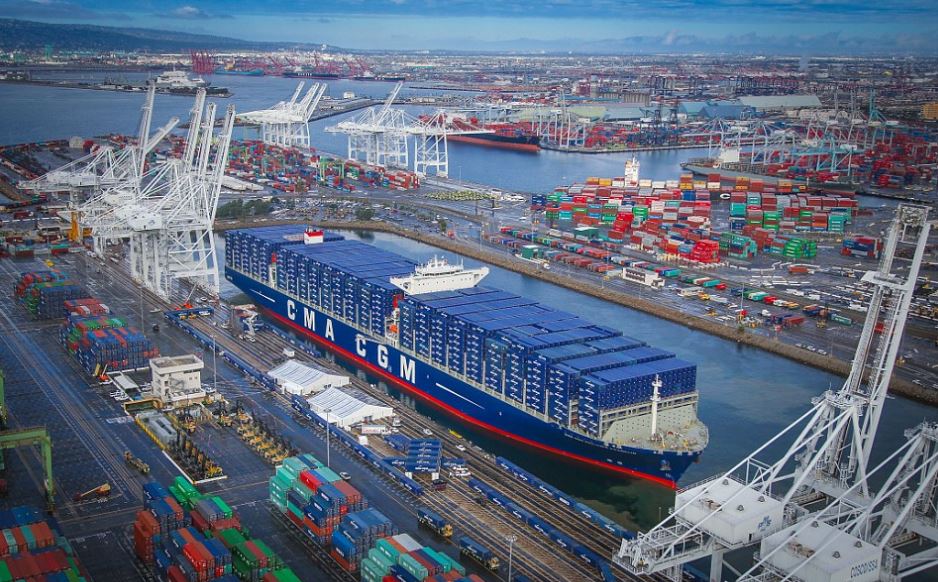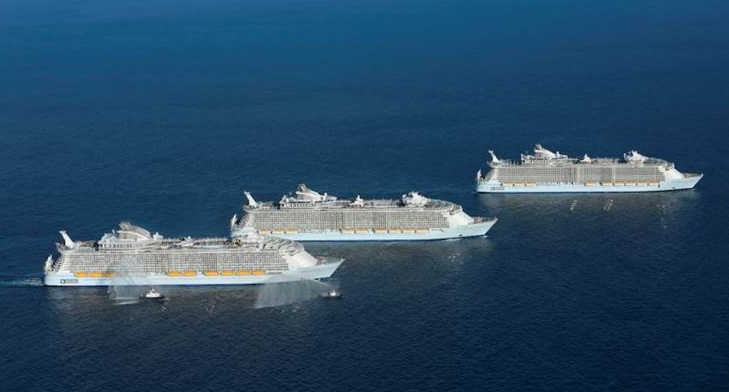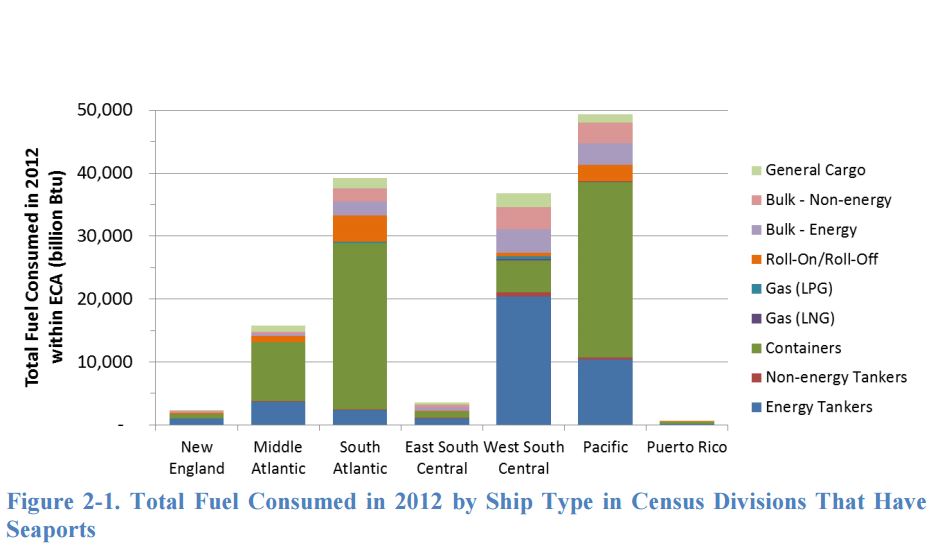New truck engine reduces NOx emissions to near zero – 90% below current limit
There are a lot of trucks required to transport freight, containers and other cargo around a port. One of largest drayage trucking companies in the Ports of Los Angeles and Long Beach has begun using one of the first Cummins Westport (CWI) ISX12 G low NOx natural gas engines for trucking operations.
The self-described game-changer’s exhaust emissions are 90% lower than the current EPA NOx limit of 0.2 g/bhp-hr.

Port of Long Beach showing world’s largest container ship rendering: lots of trucks required. Source: Port of Long Beach, California
Emissions from this natgas engine are ‘equivalent to a 100% battery truck using electricity from a modern combined cycle natural gas power plant’
California’s Air Resources Board has defined this certified Near Zero emissions level of 0.02 g/bhp-hr NOx as equivalent to a 100% battery truck using electricity from a modern combined cycle natural gas power plant. The ISL G NZ also meets the 2017 EPA greenhouse gas emission requirements with a 9% GHG reduction from the current ISL G.
The production model engines will be available for commercial order later in 2017.
Cummins Westport said the 12 liter engine’s emissions will be certified by the California Air Resources Board (CARB) to produce 90 percent less NOx than the current EPA standard for heavy duty engines, and are equivalent to that of a truck powered by electricity from the electrical grid.
The ISL G Near Zero (NZ) NOx natural gas engine is the first MidRange engine in North America to receive emission certifications from both the U.S. Environmental Protection Agency (EPA) and Air Resources Board (ARB) in California for meeting the 0.02 g/bhp-hr optional Near Zero NOx Emissions standards for medium-duty truck, urban bus, school bus, and refuse applications.
The ISL G Near Zero operates on 100% natural gas carried on the vehicle in either compressed (CNG) or liquefied (LNG) form.
Recommended maximum GCVW for the ISL G Near Zero in linehaul tractor applications is 66,000 pounds. Recommended gearing to optimize fuel economy is 1700 – 1800 rpm for linehaul applications, and 1750-1900 rpm for vocational applications, according to Cummins.
The ISL G NZ is available as a first fit engine with truck, transit, school bus and refuse OEMs, as well as for engine replacement in existing ISL G powered natural gas vehicles.
“The trucking industry is facing hard choices on how we are going to reduce our emissions impact, especially here in Southern California,” said Victor La Rosa, CEO and President of Total Transportation Services Inc.
“We understand the importance of reducing NOx emissions, especially here in California and in the middle of one of the busiest transportation corridors in the nation,” said Rob Neitzke, President of Cummins Westport. “This 12 liter engine, designed for heavy-duty trucks, can also reduce GHG methane emissions by 70% or more when run on renewable natural gas (RNG).”
About one-third of California residents live in communities with pollution that exceeds federal standards, according to estimates by CARB.
California regulators announce stricter air pollution standards for automakers
The Los Angles Times reported today that using its decades old anti-smog authority, “California regulators on Friday moved forward with tough new pollution-reduction requirements for automakers selling cars in the state.
“The rules set escalating targets for reducing greenhouse gas emissions from 2022 through 2025, and officials are planning tougher steps after that. There’s also a requirement for automakers to sell more zero-emission vehicles and plug-in hybrids in the state, with a goal of more than 1 million on the road by 2025.”
British Columbia’s climate plan supports investments by natgas utilities to expand use of LNG as marine fuel
Meantime the Government of British Columbia announced it is taking action under the Climate Leadership Plan to support investments by natural gas utilities that will increase the use of LNG and renewable natural gas in the transportation, marine and other sectors to reduce greenhouse gas (GHG) emissions.
“We’re working with utilities to stimulate the use of LNG as a marine fuel in large, ocean-going ships, and to increase the supply and use of renewable natural gas,” said Energy and Mines Minister Bill Bennett.
“Building the market for B.C.’s abundant supplies of natural gas offers the opportunity to achieve significant GHG emissions reductions and supports jobs and economic opportunities in British Columbia’s natural gas sector.”
Amendments to the Greenhouse Gas Reduction Regulation (GGRR) under the Clean Energy Act will enable utilities to increase incentives provided to shipping companies for the conversion of vessels to run on LNG, invest in LNG bunkering (marine fueling) infrastructure, and increase the supply and use of renewable natural gas (RNG).
“We are creating market opportunities for British Columbia’s natural gas sector, offering utilities flexibility to create new incentive programs so we can continue to build a strong economy and a cleaner future,” said Deputy Premier and Minister of Natural Gas Development Rich Coleman.
Incentive to convert ocean-going tankers, cruise ships and container ships to run on LNG
Converting just one ocean-going tanker, cruise ship, or container ship to run on LNG instead of heavy fuel oil will reduce GHG emissions by about 93,500 tonnes per year, equivalent to taking over 19,800 vehicles off the road. Utility investments in LNG fuelling infrastructure will help establish B.C. as a marine bunkering center on the west coast capable of providing LNG to an increasing number of LNG vessels and leading to global reductions in GHG emissions.
RNG is derived from biogas created when organic waste decomposes at landfills, agricultural and forestry waste sites and wastewater treatment facilities. Although conventional natural gas has 25% less carbon than diesel fuel and 25-39% less than typical marine fuels, RNG is considered carbon neutral unless forestry biomass is used. In this case, if waste or dead biomass is used, RNG has lower lifecycle emissions than conventional natural gas. Increased use of RNG could result in up to 450,000 tonnes of GHG reductions per year in B.C., and will also help build the market for biogas, providing economic opportunities for local governments and farming and forestry operations.
Amendments to the GGRR will allow utilities to double the incentives available to convert vehicles and marine vessels to natural gas when the new incentives go towards vehicles using 100% RNG, and enable utilities to recover the costs of acquiring and distributing RNG in rates.
RNG can be used interchangeably with conventional natural gas and easily injected into the natural gas system, so the demand potential for renewable gas and the related GHG emissions reductions are significant.
“Natural gas is a clean and affordable source of energy and the use of RNG in British Columbia is a win for the local economy and the environment,” said Pacific Northern Gas (PNG) president Leigh Ann Shoji-Lee. “PNG is proud to be working with the Province, Skeena Sawmills, G4 Insights and the community to advance the supply and use of RNG. We are committed to advancing natural gas in the communities we serve and will continue to be an active partner with the B.C. government to achieve B.C.’s GHG reduction targets.”
Increased through-put on the natural gas storage and distribution system from LNG sales means that fixed costs are shared among more customers, thereby reducing pressure on rates for all customers, the BC government said in a press release.




